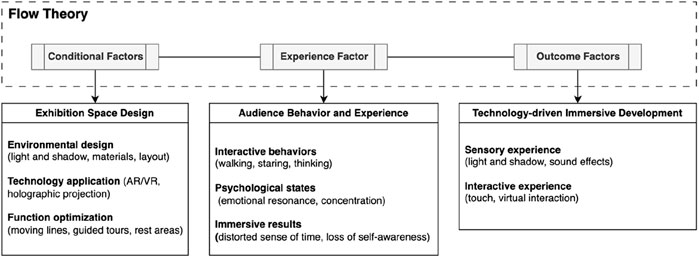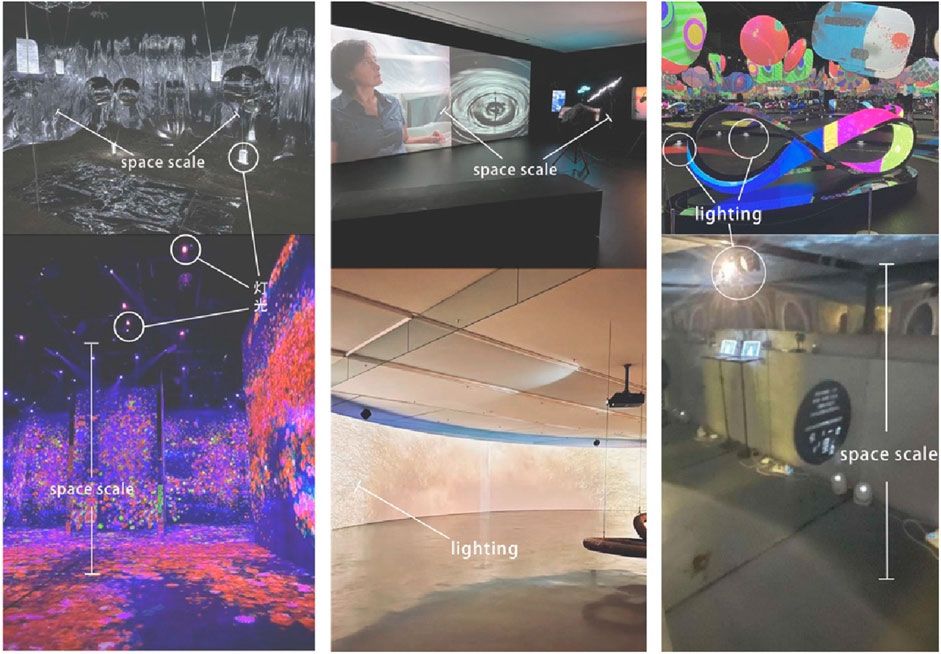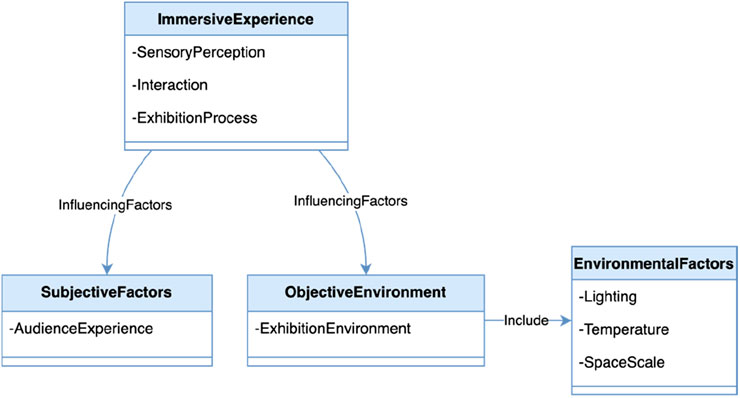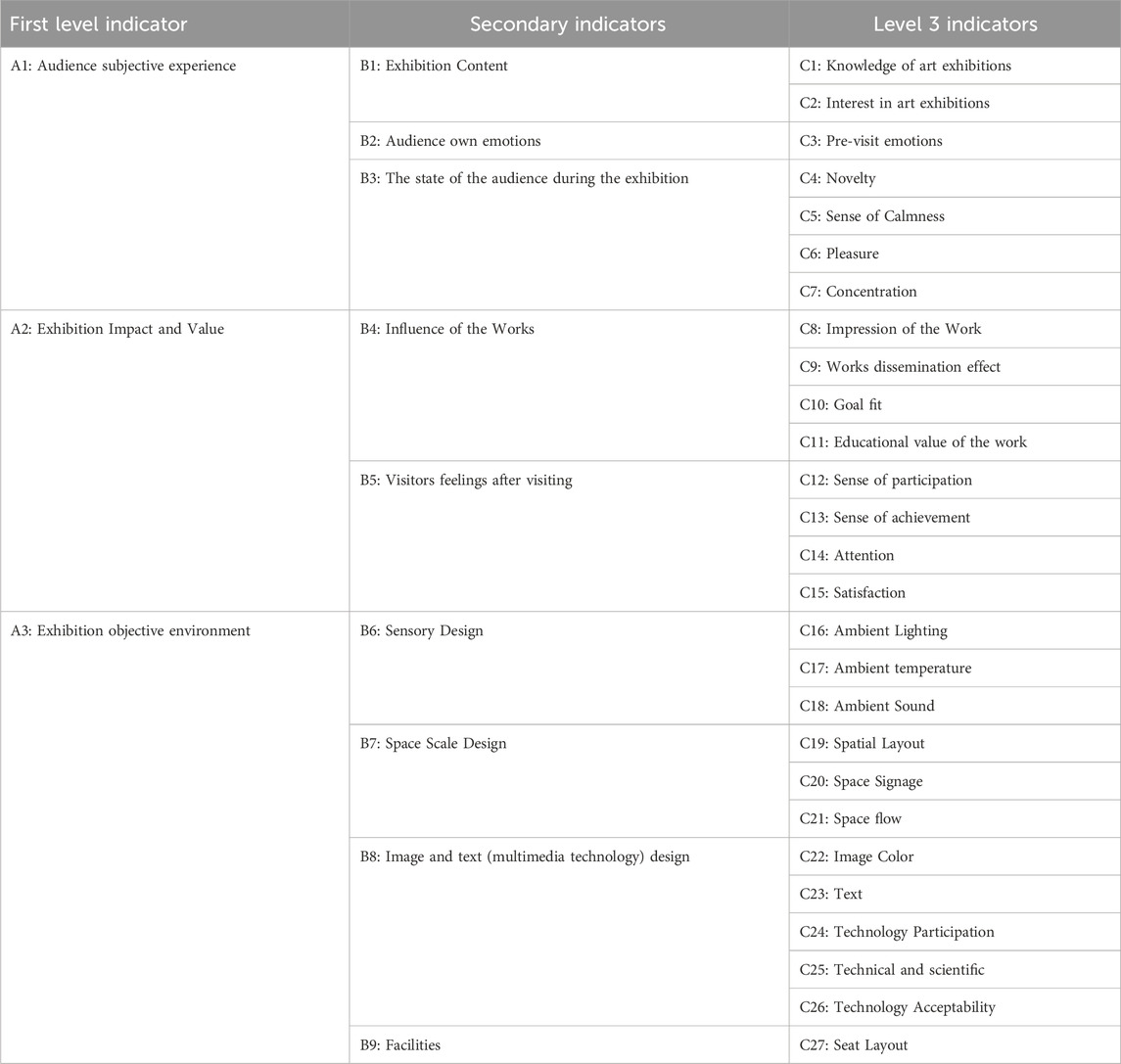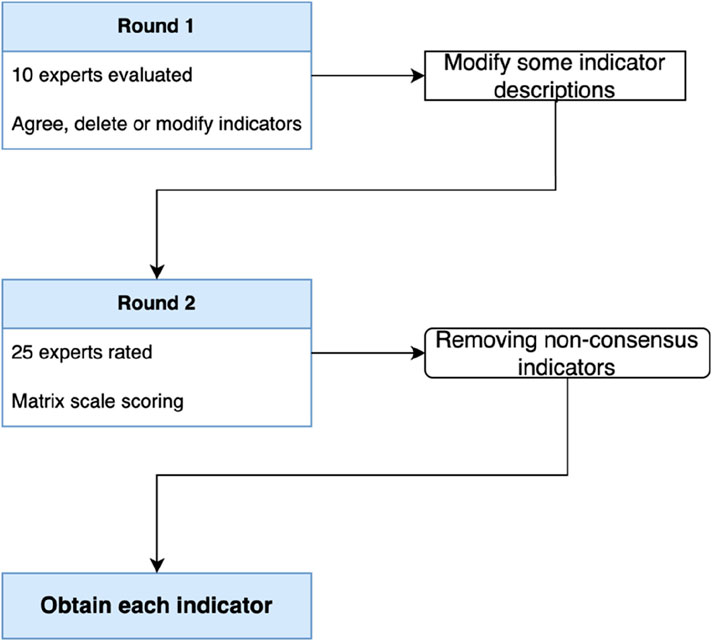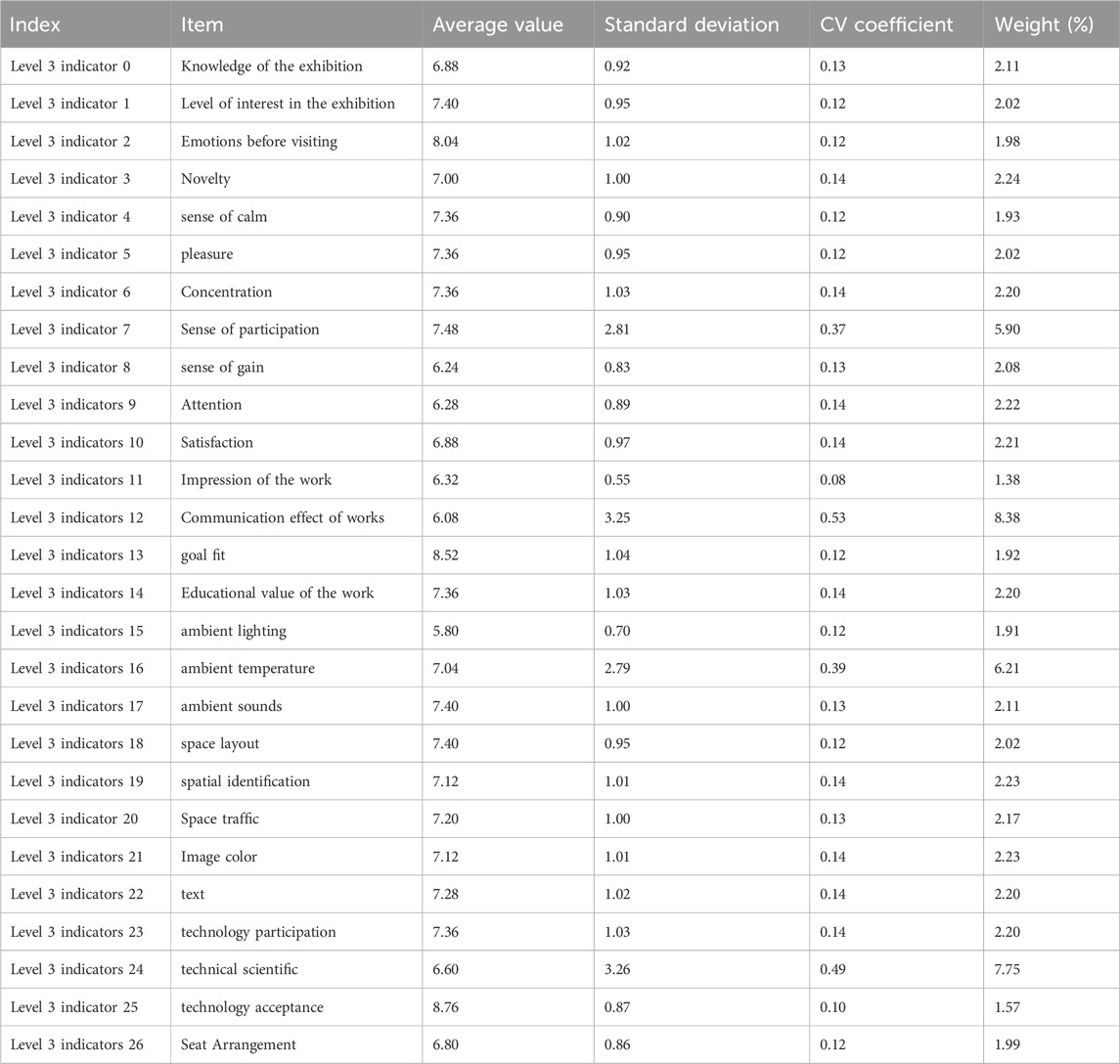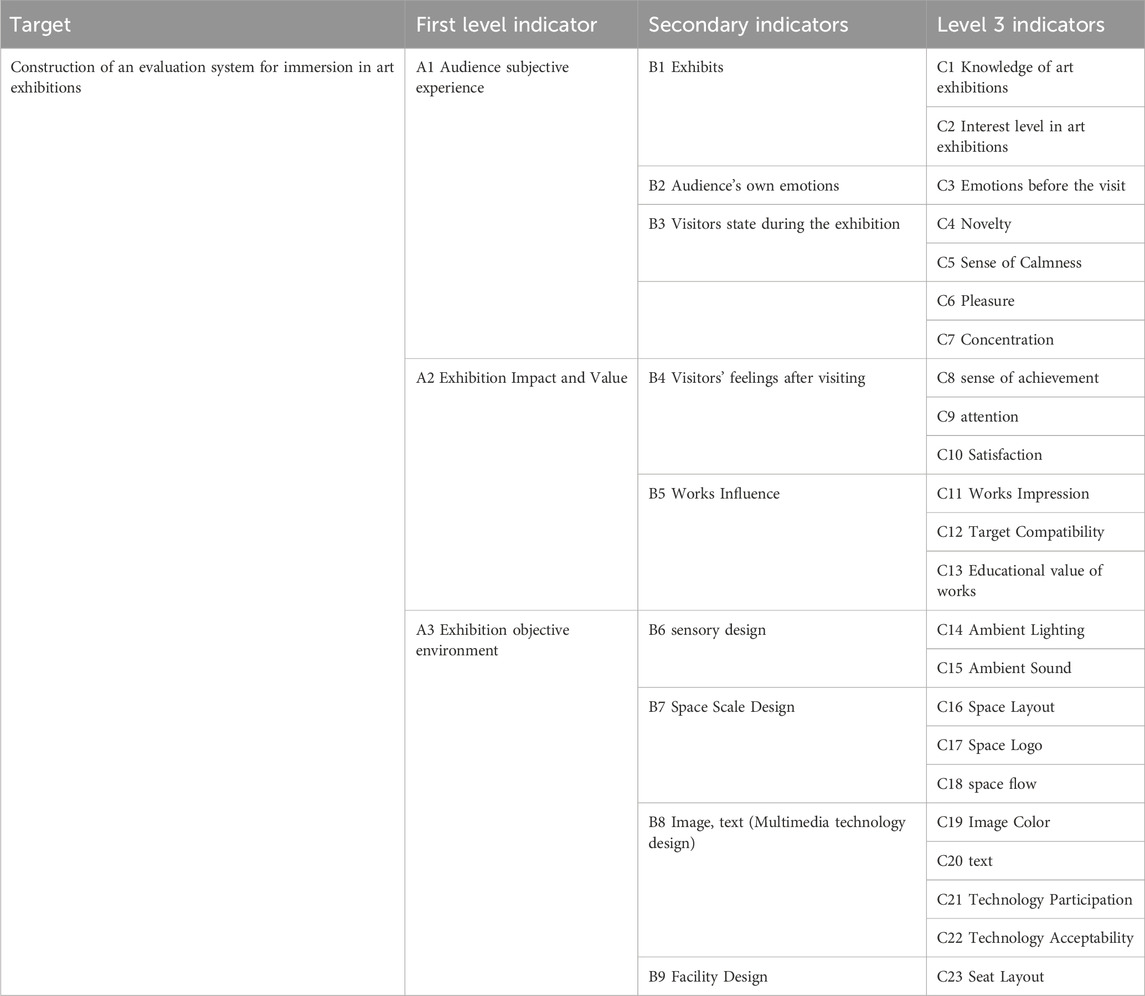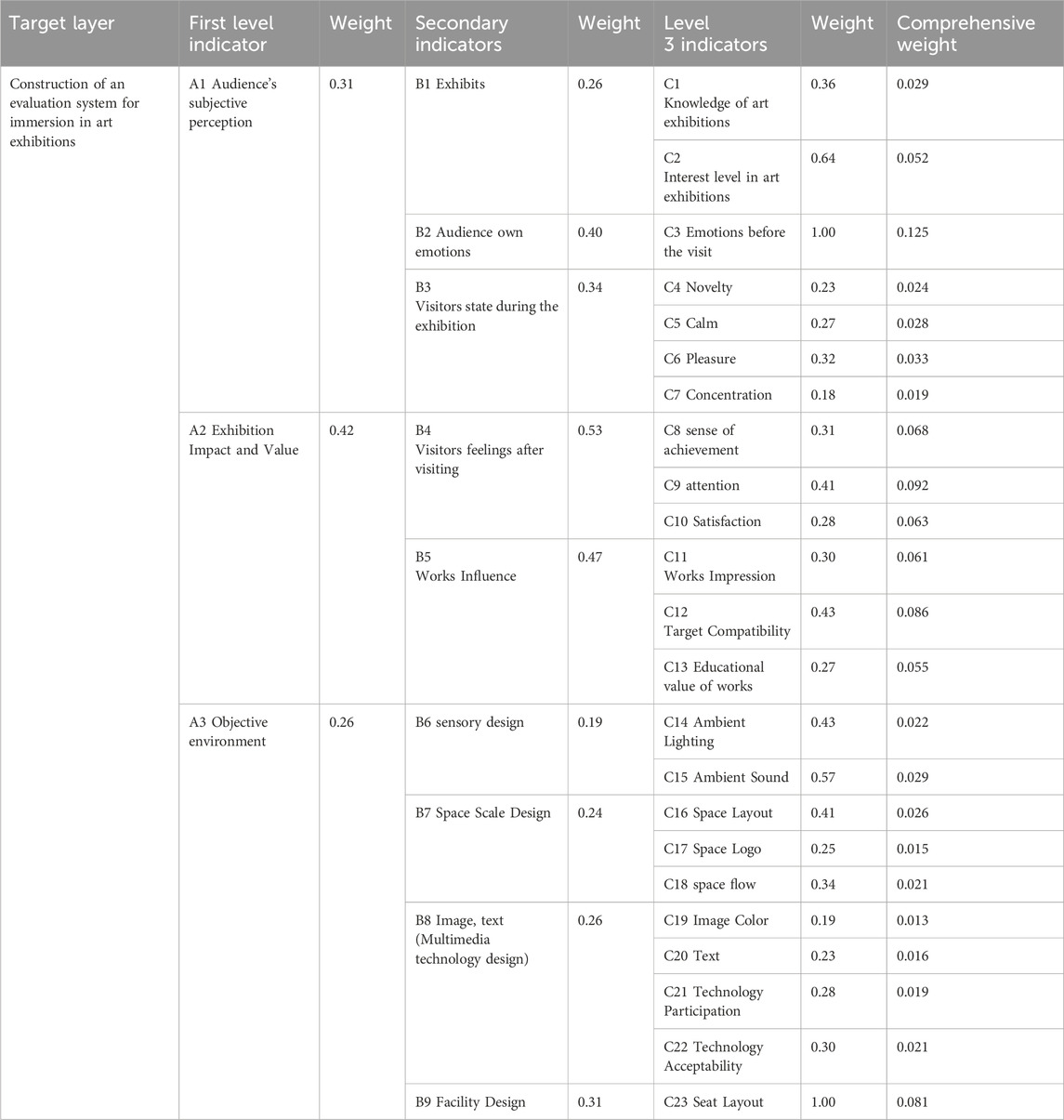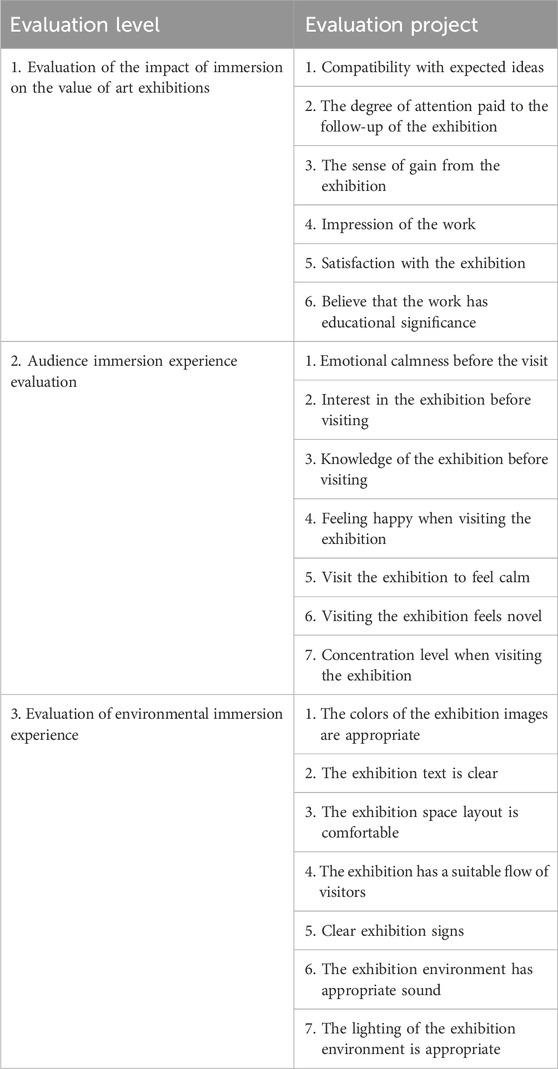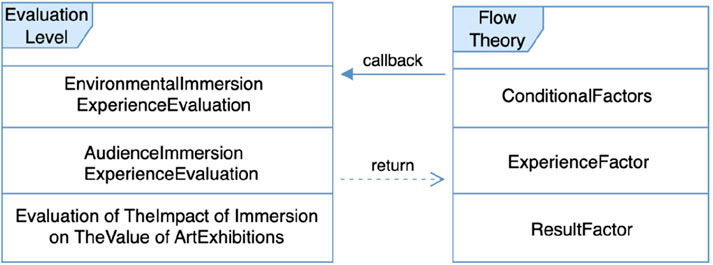- Faculty of Innovation and Design, City University of Macau, Taipa, Macao, Macao SAR, China
Introduction: In innovative art exhibitions, we create an immersive and interactive exhibition experience, where the audience can feel the transformation between virtual and reality, giving them a relaxed and pleasant sense of immersion. For example, we can improve people’s sense of immersion through interactive design, study how to use VR virtual reality technology in art exhibitions, and design visual immersion generated by large-screen interaction. Most of the research focuses on immersive technology in art exhibitions, but for the abstract concept of immersion, it is difficult to judge the audience’s immersive experience in the exhibition. This research aims to explore the factors that affect the audience’s sense of immersion in art exhibitions based on the flow theory, and to build an evaluation system for evaluating the audience’s sense of immersion.
Methods: From the perspective of flow experience, we conducted research on multiple immersive art exhibitions to explore the interactive relationship between the audience, exhibits, and exhibition halls. We used the unstructured observation method to conduct preliminary research and analysis, and used the Delphi method to let experts score the design indicators (10 in the first round and 25 in the second round) to obtain various design indicators for immersive exhibitions. Finally, we used the analytic hierarchy process to determine the weights of the evaluation indicators and establish an immersive evaluation system in art exhibitions.
Results: The results show that from the perspective of flow experience, the three main aspects of evaluating immersion in art exhibitions are the impact of the exhibition’s own value, the audience’s immersive experience, and the creation of environmental immersion. Constructing these three evaluation levels can measure the audience’s demand for highquality exhibition experience.
Discussion: The evaluation system of immersive art exhibitions constructed by this research provides a basis for the effectiveness of evaluation of future immersive art exhibitions. Starting from the sense of immersion, it explores how to concretize the sense of immersion and how to judge it. It emphasizes the process of quantifying the sense of immersion of the audience in art exhibitions.
1 Introduction
Flow experience is an audience-centered experience mode. Mihaly Csikszentmihalyi proposed the flow theory in 1990. The theory points out that when individuals participate in an activity, they may enter a cognitive state called “immersion” (Csikszentmihalyi, 1990). This state is described as fully focused on the task or activity, forgetting the surrounding environment and self-awareness. This process is called the flow experience process (Jiang et al., 2018; Zhang et al., 2023). Therefore, in art exhibitions, the audience can fully integrate into the presented environment or scene. The exhibitor can create a stronger sense of immersion through carefully designed elements and interactive methods, thereby more effectively conveying information to the audience (Nilsson et al., 2016; Ai and Li, 2021). Therefore, immersion and display are closely related concepts in the field of exhibitions.
In the exhibition context, immersion emphasizes the deep interaction and emotional investment between the audience and the exhibition content, while “display” focuses more on the carefully designed exhibition layout and exhibits (He et al., 2021). The combination of the two guides the audience’s perception and cognitive experience process in the exhibition (Nilsson et al., 2016). According to the proposal of flow theory, it has also been combined with research in many fields. Liu Yan et al. studied the online experience of the tourism consumption industry and analyzed consumers’ rebooking by introducing flow theory (Liu et al., 2016). Li Jingjie analyzed the interference factors of adult online deep learning through flow theory and proposed corresponding optimization strategies (Li, 2019). With the development of flow theory, not only has the research problems in many fields been expanded, but also related research on immersion in the process of flow experience has begun to appear. Wu Yugong explored the main factors of “immersion” in immersive exhibitions. He believes that immersion should not only focus on the objective immersive environment created by the curator but also pay attention to the subjective experience of the audience. By studying the objective environment and the audience’s subjective experience, the factors that affect immersion are analyzed (Wu, 2019). With the development of flow experience, researchers have developed various scales and questionnaire tools for its influencing factors, which can be quantitatively analyzed (Curran, 2018). Flow experience has been widely used in education, mental health, game design (Wang and Zhai, 2021; Berkman and Akan, 2024), sports (Li, 2019) and other fields (Cheng et al., 2022; Ma, 2022), but there are few analyses of the immersion of exhibition space from the perspective of flow experience.
1.1 Immersion factors in flow experience
The concept of immersion can be judged from two levels: behavioral and psychological. From the perspective of behavioral immersion, the behavior of the crowd is analyzed (Weiss, 1999), and the immersion is measured mainly in the form of experiments to research whether the behavior is immersed (Bostwick, 2006). Psychological immersion is analyzed from the psychological level, mainly from the subjective level of the crowd (Douglas and Hargadon, 2000), and the immersion is analyzed based on the subjective experience. Csikszentmihalyi summarized the three factors and nine characteristics of flow. The conditional factors include clear goals, real-time feedback, and the perception of skills and challenges; the experience factors include the integration of behavior and consciousness, complete concentration of attention, and potential sense of control; the result factors include the loss of self-awareness, the distortion of time perception, and the sense of participation with a self-contained purpose (Csikszentmihalyi, 2000).
1.2 The role of space in art exhibitions
Art exhibitions, as an extremely important display platform in the art world, have a profound impact on the expressiveness of artworks and the overall experience of the audience through their display characteristics in indoor spaces (Wang, 2022). The indoor space of an art exhibition is not just a simple decoration or layout, it carries a more important function (Gong, 2021; Spittle et al., 2022). The carefully planned layout, the clever use of light and shadow, and the clever combination of materials by designers are all aimed at creating a spatial environment that is both in line with the style of the artwork and can stimulate the emotional resonance of the audience (Grau, 2024; Liu, 2022; Oriti et al., 2023). Such a design can not only allow the artwork to be presented to the audience in the best state, but also make the entire exhibition process a double feast of vision and soul (Wang, 2020; Bowman and McMahan, 2007)). Designers will use professional design skills and aesthetic concepts, and through careful arrangement, each exhibit can be displayed just right (Mou Tingqing, 2019; Ryan, 1999). The use of light and shadow is crucial in exhibition design. Soft light can make the artwork appear more three-dimensional and vivid, while strong contrasting light and shadow can highlight the texture and layering of the artwork. The matching of materials is equally important. Different materials can bring different visual and tactile experiences, thereby enhance the audience’s perception and understanding of the artwork (Shin, 2019). In the exhibition environment, the role of the audience is not just a passive recipient. On the contrary, they are active participants, and their behavior and reactions will have a profound impact on the overall atmosphere of the exhibition. The audience interacts deeply with the artwork and the exhibition space through walking, stopping, gazing, thinking and other behaviors (Yan, 2006). This interaction is not only a superficial understanding and perception of the content of the work, but also a perception and feedback of the overall atmosphere of the exhibition (Zhang et al., 2023). The emotional experience, aesthetic preferences and even cultural background of each audience will be fully reflected in this process. At the same time, the comfort and convenience of the exhibition environment are also important factors affecting the audience experience (Deng, 2021). A good exhibition environment should have a reasonable flow design so that the audience can smoothly visit each exhibit; it should provide sufficient rest space so that tired audiences can get a short rest (Kan, 2005); and there should be clear guide signs to help the audience quickly find the exhibits they want to see. These factors can effectively improve the audience’s satisfaction and participation, allowing them to feel the dedication and care of the exhibition organizers while appreciating the works of art.
1.3 The development of immersive experience in art exhibitions
At the macro level, all ways of displaying artworks can be considered art exhibitions. This includes art exhibitions open to the public, as well as hanging and displaying artworks in private spaces (Luo 2018). At the micro level, art exhibitions usually refer to public displays in a specific space, time and theme (Feng 2022). Such exhibitions usually require the artworks to be displayed in one place so that people can come to watch and communicate (Lu and Wu, 2023). These exhibitions can be independent exhibitions of individual artists, joint exhibitions of groups of artists, exhibitions of specific styles or themes, etc. (He 2021; Tang, 2022). In current art exhibitions, immersive exhibitions are widely welcomed by everyone. For immersive art exhibitions, how can we define an exhibition as immersive? (Zhou, 2023). A series of “immersive” experiences have emerged in life, such as the emergence of immersive makeup and immersive eating broadcasts by Internet celebrities (Yu and Xu, 2017). There are also many art exhibitions that claim to be immersive exhibitions, but there is no in-depth discussion on how to define whether the audience is immersed in such exhibitions and how to define the specific degree of immersive experience.
Wang Hong et al. believe that the media technology of the 21st century has brought the potential of creating immersive exhibitions to museum exhibitions. AR technology and VR technology in new media imaging technology can produce a strong immersive experience. They also divide the immersive experience into two levels: sensory experience and interactive experience for research and analysis (Wang and Liu, 2018; Chen, 2021). Zhang Likun et al. explored the immersive technical means of museums and the audience’s immersive psychological perception through immersive research on digital museums. They believe that digital multimedia technology can bring immersion to museum exhibition experience (Zhang and Tian, 2022; Dai et al., 2023). Fan Haoyu et al., through the study of the immersive experience of smart museums, believe that immersion in space creates a virtual environment with the help of technologies such as virtual reality, holographic projection, spatial sensing and three-dimensional display, which makes the audience feel immersed (Xu, 2022). They believe that the immersive experience of smart museums is different from the passive experience of digital museums, so they studied the immersive physical environment in space (Fan and Cai, 2023; Fu et al., 2023). Through the review of the above literature and the status of immersive art exhibitions, this paper mainly studies immersive environment art exhibitions created by digital media technology (Tang, 2022), such as the application of holographic projection technology, computer-generated virtual scene exhibition halls, multimedia technology interactive exhibitions, etc. (Li, 2023). This type of immersive exhibition mainly creates and designs the exhibition environment in which the audience is located, which is different from the immersive feeling brought by auxiliary tools such as AR and VR that have restrictions on the crowd (Hu, 2023).
1.4 Research questions
This study hopes to start from the sense of immersion and explore how to concretize the sense of immersion: 1. The influencing factors of the interaction between the audience’s perception and the exhibition environment; 2. How the audience’s subjective experience, the value impact of the exhibition, and the objective environment of the exhibition affect the audience’s immersive experience; 3. How to verify the rationality of the ranking of various indicators, so as to construct an evaluation system for immersive art exhibitions and provide a validity basis for subsequent immersive design and evaluation of immersive exhibitions. This research established evaluation indicators through the opinions provided by experts, literature collection and field research, and distributed the evaluation system in the form of questionnaires in relevant immersive art exhibitions. Understand the audience’s views on the factors that affect immersion and the corresponding weights in each exhibition, to verify the feasibility of this immersive art exhibition evaluation system.
2 Methods
This study uses unstructured observation, Delphi method, questionnaire method and hierarchical analysis method to construct an evaluation system for the immersion of art exhibitions. This paper uses a methodological system that combines empirical research with system analysis and constructs an evaluation system for the immersion of art exhibitions through multi-dimensional research methods. The use of qualitative and quantitative research can more scientifically and detailed analyze the factors and indicators that affect the immersion in art exhibitions.
2.1 Research design
This research uses unstructured observation methods to observe the behavior of different groups of people in art exhibitions, analyzes the problems and satisfaction of the audience groups in the exhibition, and conducts field research on art exhibitions in the Greater Bay Area of China. The analysis is consistent with the flow theory, elements that produce a flow experience. Then the Delphi Method is used, which is a research method that asks experts and puts forward expert opinions (Blau, 1977). By sending questionnaires to multiple experts to fill in, a consensus opinion is reached based on the feedback, which provides the basis for the research. Provide professional knowledge support. This method uses a systematic iterative approach and requires repeated surveys and questionnaire filling to narrow the differences in opinions when collecting expert opinions. Finally, the analytic hierarchy process is used to establish a judgment matrix, and the weight ranking is calculated through matrix analysis of various indicators, thereby determining the weight of each indicator in the evaluation system and establishing an immersive evaluation system for art exhibitions (Ma and Wang, 2018; Mei and Li, 2018).
2.2 Establishment of immersion index based on unstructured observation method
2.2.1 Analysis of factors of flow experience in art exhibitions
This research investigated immersive exhibitions in the Guangdong-Hong Kong-Macao Greater Bay Area of China and conducted on-site correlation research on art exhibitions using non-structured observation methods. Through the analysis of various factors that affect the immersion experience, combined with the analysis of various factors in immersion research in the literature, it is first proposed that the immersion in the exhibition will be affected by subjective and objective factors. Subjectivity is the experience of the audience themselves, and objectiveness is the exhibition environment (Li and Ma, 2022) (Figure 1). It can also be said that immersion is related to the senses, interaction (Hudson et al., 2019) and the audience’s viewing process (Zhao, 2021). The objective environment of the exhibition is considered from the environment itself (Kang and Tian, 2021; Liu and Ren, 2019), such as lighting, temperature, spatial scale, etc., mainly focusing on “Macau team lab exhibition” (Qisheng, 2020), “Macau Museum of Art”, “Super Yuanxiang: Xiao Dong Exhibition”, “Macau’s non-poetry, non-poetry” Non-Poetry Exhibition”, “Shenzhen Contemporary Art and Urban Planning Museum”, and “Guangzhou Stars and Waves Exhibition” are shown in Figure 2. The subjective experience of the audience can be studied through three stages before, during and after the exhibition. For the audience in different periods the sense of experience is different (Frost et al., 2022), so this research will study the entire exhibition viewing process (Baños et al., 2004) to better find the audience’s heart during the exhibition viewing process. Flow changes to find the influencing factors of immersion are shown in Figure 3. The immersion in art exhibitions is mainly judged from sensory experience, interactive experience and exhibition experience. The factors that affect these three experiences are mainly subjective factors and objective factors, and the objective factors also include environmental factors. Therefore, this study explores the impact of the audience’s state and feelings in the subjective factors and the environmental factors in the objective factors on the immersive experience of art exhibitions (Chen, 2012). The analysis is conducted based on the factors of the flow experience process combined with the objective environment of the exhibition and the subjective experience of the audience (Smith and Mulligan, 2021). Starting from the objective environment of the exhibition, we can consider it from the aspects of senses, spatial scale, images and facilities in the exhibition; the subjective experience of the audience starts from the understanding of the exhibition before viewing the exhibition, the individual’s own emotions, and the feelings during the exhibition. The impact on the exhibition works after viewing the exhibition and the impact of the exhibition on the audience can be considered from these points as shown in Figure 4. The three stages of flow correspond to the objective environmental factors of the exhibition and the subjective experience of the audience proposed in the study. The objective environment of the exhibition and the audience’s understanding and emotional state before the exhibition can be corresponded to the precursors of flow. The audience’s feelings about the exhibition can be corresponded to the flow experience. The impact of the works and the emotional impact on the audience after the exhibition can be corresponded to the results of flow.
2.2.2 Design indicators
According to the comparison table of immersive experience factors, the experience factors that affect the audience’s immersion in art exhibitions can be divided into subjective, objective and influencing value (Liu and Sutunyarak, 2024; Liu, 2021). Therefore, three first-level indicators are obtained: audience subjective experience, exhibition objective environment, exhibition impact and value; the second-level indicators are obtained by analyzing the influencing factors in more detail based on the corresponding first-level indicators, mainly analyzing the possible influencing factors before, during and after the exhibition, so there are 9 second-level indicators in total: exhibition content, audience’s own emotions, audience’s state during the exhibition, audience’s feelings after the visit, work influence, sensory design, space scale design, image text (multimedia design), facility design; The third-level indicators are divided into detailed categories according to the corresponding second-level indicators, and are also analyzed according to the influencing factors before, during and after the exhibition. Therefore, there are 27 third-level indicators in total: degree of understanding of art exhibitions, interest in art exhibitions, emotions before visiting, novelty, calmness, pleasure, concentration, sense of gain, sense of participation, attention, satisfaction, impression of works, goal fit, educational value of works, ambient lighting, ambient temperature, ambient sound, space layout, space signs, space flow, image color, text, technical participation, technical scientific, technical acceptance, and seating arrangement, see Table 1.
2.3 Immersion index screening based on delphi method
The expert questionnaire designed for this research explored the three main design principles of art exhibitions: audience subjective experience, the impact and value of works, and the objective environment of exhibitions. Through the collection and analysis of relevant literature and the investigation of immersive exhibitions, nine secondary indicators and twenty-seven tertiary indicators were designed. The establishment of each evaluation indicator is based on the opinions given by experts. Through the questionnaire survey of experts in the field of design, experts have rich professional knowledge and practical experience, so it has guiding significance for the immersive evaluation system of immersive art exhibitions (Addison-Wesley, 1975). This study uses a weighted process to integrate and analyze data by assigning specific weight coefficients according to the importance of different attributes or indicators of the research object. Its core is to reflect the difference in the contribution of each factor to the overall goal through mathematical quantification. The weighted analysis using the analytic hierarchy process mainly includes three key links. Construct an indicator system to decompose complex problems into multi-level indicators (goal level, criterion level, and solution level); determine the weights based on expert experience (Delphi method), construct a judgment matrix by comparing the importance of indicators pairwise, and calculate the weights (Han et al., 2024). Weighted calculation and verification perform weighted summation on the standardized indicator values. The main tools used in this study are SPSS and yaahp, which can be carried out from multiple dimensions such as research efficiency, result reliability, and method innovation. The scientific application of tools can significantly improve the quality of research (Figure 5).
2.3.1 First round questionnaire design
The first round of questionnaires was mainly for experts to decide whether to agree, delete or modify the secondary and tertiary indicators that affect immersion. The returned questionnaires were sorted out, and the indicators were deleted and modified according to the opinions of the experts. In the questionnaire for the first round of indicator evaluation and modification opinions, 10 experts in the design field were invited, including designers, university teachers, and university professors. The questionnaires were sent through Questionnaire Star and email, and the opinions on the establishment of indicators were collected from the 10 experts.
After collecting and counting the questionnaires, the following conclusions were drawn: 1. Whether the emotions before the visit are too subjective and whether they are helpful for subsequent research; 2. How to define novelty; 3. It is suggested that vision can be subdivided into ambient lighting and ambient color; 4. The number of seats is also critical; 5. It is not appropriate to say sense of accomplishment, it is more appropriate to say sense of gain; 6. Whether sense of participation is difficult to judge; therefore, the sense of accomplishment in the three-level indicator is changed to sense of participation (Li and Wang, 2018).
2.3.2 Second round questionnaire design
After collecting the first questionnaire, the evaluation indicators were modified according to the modification suggestions of the experts. After the modification, a matrix scale was established and sent to 25 experts for scoring using Questionnaire Star. 25 questionnaires were issued, and 25 valid questionnaires were collected. Each indicator was scored using a 10-level scale, and each expert scored the importance of the indicator and agreed to its influence. According to the statistical results, the overall mean, standard deviation, and coefficient of variation of each expert’s score for each indicator were calculated. Experts judged whether the opinions of the experts on the indicators that affect the sense of immersion in the immersive exhibition could reach a consensus. Indicators that could not reach a consensus would be deleted.
The score in the questionnaire scale is [1, 10]. When the overall mean is larger, the coefficient of variation is smaller; when the coefficient of variation is larger, the overall mean is smaller. Therefore, when the consensus difference index is smaller, it means that the experts have a higher degree of consensus on this index. When the CV coefficient is greater than 0.3, it means that the indicator has reached a consensus; if the CV index is less than 0.3, it means that the indicator has not reached a consensus. Coefficient of Variation is a standardized indicator used in statistics to measure the degree of data dispersion. Its core function is to eliminate the impact of dimension and mean differences, thereby achieving an objective comparison of the volatility of different data sets or variables. It can be used to evaluate the stability of the same indicator in different groups. Even if the means differ greatly, the CV coefficient can still reflect the relative dispersion. The CV coefficient is defined as the ratio of the absolute value of the standard deviation
Standard deviation
The final data can be obtained through the above calculations.
The third-level indicators are the solution layers derived from the first-level indicator target layer and the second-level indicator criterion layer. Each level decreases successively, and it also belongs to the relationship of inclusion and being included. The third-level indicators are mainly designed from the environmental factors, work factors, and personal emotional factors involved in the overall process from before to after the exhibition. They were also modified and deleted through expert review opinions, and finally 26 third-level indicators were obtained for coefficient of variation calculation. According to the data analysis, we can derive the following three-level indicators: the CV coefficient of sense of participation is 0.37; the third-level indicator: the CV coefficient of the communication effect of the work is 0.53; the third-level indicator: the CV coefficient of ambient temperature is 0.396; the third-level indicator: the CV coefficient of technical scientific is 0.49; the expert consensus of these four indicators is too low, indicating that no consensus has been reached on the indicator, so these four indicators are deleted.
2.4 Construction of immersion evaluation system based on analytic hierarchy process
2.4.1 Matrix indicator design
Through the first and second rounds of indicator scoring questionnaire analysis, the indicators with large comprehensive difference values of each expert were deleted. After integrating the indicator system, a judgment matrix table between the three-level indicators was constructed, aiming to derive the importance ranking of each level indicator by comparing the two judgment matrices.
Based on referring to relevant literature and data, and then through the investigation of relevant art exhibitions, combined with the characteristics of flow theory factors, we can correspond to the audience’s visit to the art exhibition before, during and after the visit from the three levels of flow precursor, flow experience and flow result (Zhang, 2022; Zhang and Li, 2024). According to the environmental factors, work factors and audience emotional factors involved in the visiting process, corresponding analysis is carried out. Thus, the first-level indicators include subjective and objective factors and the value factors of the works themselves. The second-level indicator criteria layer is to analyze the content of the art exhibition, the emotional changes of the audience and the influence of the environment. The third-level indicator scheme layer is a more detailed analysis of the detailed factors of the environment, emotion and work value in the art exhibition. Finally, the Delphi method is used to support the scientific and accuracy of the three levels (Wu et al., 2023; Xie et al., 2021). Combined with the research and analysis of this study, the following indicators are obtained. See Table 2 for the evaluation indicator system framework, which includes one target layer, three first-level indicators, 9 second-level indicators, and 23 third-level indicators (Su, 2022).
2.4.2 Determining indicator weights
This research used AHP to determine the weights of indicators (Li et al., 2018) and invited 10 experts in the design field, including designers, university teachers, and university professors. The questionnaire was sent via email.
(1) Building a hierarchical model
First, based on the existing evaluation system, the evaluation system is divided into the target layer, the first-level indicator layer, the second-level indicator layer, and the third-level indicator layer. Next, a structural model is established according to these four levels.
(2) Creating a contrast matrix
Under the same standard, pairwise comparison is performed to obtain the judgment matrix A (Liu and Liu, 2005). The quantitative comparison and scoring standards used are shown in the following table:
(3) Integration of Expert Rating Matrix
To ensure the effectiveness of the consistency test, we use the geometric mean method. The specific operation is multiplying the corresponding elements of the scoring matrix provided by each expert one by one and then take the nth root of the product result to obtain a unified integrated matrix.
k is the kth expert, m is the nth matrix, and
(4) Determining the relative weights of the judgment matrix
The geometric mean method (also known as the square root method) is used to process the integrated unique matrix to obtain the weight, as shown in Formula 1 (Liu and Liu, 2005).
The specific steps are as follows: First, multiply each row of matrix A to generate a new vector; then, take the nth root of each element of this new vector; finally, normalize the obtained vector to get the required weight vector.
(5) Evaluation Matrix Consistency
In academic research, the CR value is usually used to evaluate the consistency of the judgment matrix. CR is the ratio between the consistency index CI and the average random consistency index RI. When CR is less than 0.1, it is considered that the matrix meets the consistency requirements, and no further adjustment is required. CR is calculated according to the following Formula 2 (Liu and Liu, 2005).
The calculation of CI follows the instructions of Formula 3.
3 Results
3.1 Calculation of design index weights
The weights of the first-level indicators A1-A3, the second-level indicators B1-B9, and the third-level indicators C1-C22 were calculated (Wang, 2024). After ensuring that the 10 expert judgment matrices met the consistency requirements (CR < 0.1), the 10 judgment matrices were assembled, and the weights and consistency calculations of the criterion layer integration matrix were performed to obtain the weights and consistency calculation results of the indicators at all levels. The weights of the above indicators are summarized in Table 4, and the immersion evaluation system is obtained.
It can be concluded from the table that in the first-level indicators, the weight of the exhibition impact and value is 0.42, which accounts for the highest proportion; followed by the audience’s subjective experience, with a weight of 0.31; and finally the exhibition’s objective environment, with a weight of 0.26; therefore, the exhibition impact and value are the most important in the evaluation of the immersion of art exhibitions. There are nine indicators in the second-level level, among which the highest weight is 0.53, which is the audience’s feeling after the visit; the lowest weight is sensory design, with a value of 0.19; therefore, the audience’s feeling after the visit is more important in the second-level level. There are 23 indicators in the third-level level, among which the highest weight is the mood before the visit and the arrangement of the seats, with a value of 1.00; therefore, the mood of the audience before the visit and the arrangement of the seats in the art exhibition are more important in the third-level level.
3.2 Use of the art exhibition immersion evaluation system
The above data analysis results are summarized and summarized, and the weight ranking is classified into levels and items. The impact and value of the exhibition account for the largest proportion in the first level, followed by the subjective experience of the audience and the objective environment of the exhibition. Therefore, the art exhibition immersion evaluation system is divided into three evaluation levels, namely, the evaluation of the impact of immersion on the exhibition’s own value, the evaluation of the audience’s immersion experience, and the evaluation of the environmental immersion experience. The three evaluation levels contain different evaluation items, which are sorted according to the weights of the third level. See Table 5. Among them, the evaluation of the impact of immersion on the value of the art exhibition itself contains six evaluation items, and the audience’s fit with the expected ideas and the subsequent attention to the exhibition are more important; the evaluation of the audience’s immersion experience contains seven evaluation items, and the audience’s emotions before the visit and the evaluation of the interest in the exhibition are more important; the evaluation of the environmental immersion experience contains seven evaluation items, and the evaluation of the exhibition image color and the exhibition text is more important. According to the given evaluation levels and evaluation items, the weights of the items at each level can be calculated according to the above indicators. The score of the exhibition can also be calculated by fuzzy comprehensive analysis, and finally the exhibition immersion score is obtained to evaluate the immersion of the art exhibition.
The art exhibition immersion evaluation system constructed in this research presents the relationship between the audience’s experience process when visiting an art exhibition and the exhibition itself and corresponds to the audience’s experience process based on the factors that produce flow experience in the flow theory. The flow experience factors produced by the audience in the art exhibition are constructed as the evaluation indicators in the research. Therefore, the three evaluation levels in the evaluation system of this research, the environmental immersion experience evaluation, the audience immersion experience evaluation, and the evaluation of the impact of immersion on the value of the art exhibition itself, can be corresponded to the conditional factors, experience factors, and result factors of the flow experience Figure 6. The three levels form a progressive relationship from “environmental design” to “audience experience” to “value enhancement”, reflecting the complete chain of immersion from basic construction to the final effect. The flow theory explains how the audience can achieve an immersive experience through high concentration and involvement (flow state). It is directly related to the “audience immersive experience evaluation”, emphasizing the fluency and emotional depth of the experience. Conditional factors refer to the objective conditions for achieving immersion (such as technical equipment, exhibit quality, and space planning), corresponding to the “environmental immersive experience evaluation”. Experience factors refer to the audience’s subjective experience dimensions (such as interactivity and emotional resonance), corresponding to the “audience immersive experience evaluation”. The audience feedback collection mechanism (such as questionnaires) is used to optimize the “conditional factors” and “experience factors”. The output of the evaluation results provides a basis for exhibition improvement or value assessment by analyzing the immersive data.
4 Discussion
Immersive exhibition is a form of display that combines modern technology and artistic creativity. It allows the audience to experience the theme content presented in the exhibition in an immersive way. The advancement of science and technology has injected more innovative vitality into immersive exhibitions. Previous research in this area has mainly focused on the impact of new technologies on audience perception in immersive experience. This study mainly discusses the immersive experience in smaller exhibition halls in the Greater Bay Area. Through the screening of the Feld method, the research indicators were changed from two to three. Based on the two indicators of the audience’s subjective perception and the objective environment of the exhibition hall, the value of the exhibition itself was added to the evaluation of the immersion of the art exhibition. The focus was on discussing the audience’s perception ranking between the environment and the exhibition under objective influence. Through the weight analysis and experience evaluation of the ranking, curators can combine virtual reality, augmented reality and other technologies according to the focus of the exhibition content, and enhance the development space of immersive exhibitions through a combination of different conditions and factors (Tedick and Fortune, 2012). This research also conducted an immersive evaluation system study on immersive exhibitions in the Greater Bay Area to provide an evaluation for the immersive experience design in subsequent art exhibitions and provide support for the quantification of immersion in art exhibitions (Engeser et al., 2021). The research proposed that in immersive art exhibitions, the importance of immersion in the evaluation of the exhibition’s own value accounts for the largest proportion, followed by the audience’s immersive experience evaluation and the environmental immersive experience evaluation. In previous studies, it was proposed that the audience’s immersive experience in art exhibitions is affected by the environment and their own emotional experience (Wu, 2019). This research added the factor of immersion affecting the exhibition’s own value and analyzed and ranked the influencing factors and weights of these three factors. In this research, we also conducted research and analysis on the factors that produce flow experience in the objective environment of the exhibition and the subjective experience of the audience, including conditional factors, experience factors, and result factors (Csikszentmihalyi, 2000), and conducted corresponding research on each relevant indicator. In subsequent studies, we can develop a scale questionnaire for immersive art exhibitions or museums based on the various evaluation levels and items proposed in this research, which can more conveniently judge the audience’s experience satisfaction with art exhibitions or museums.
Based on this research, the judgment of immersion still has certain limitations. First, this research focuses on immersive exhibitions in the Greater Bay Area, which may have geographical limitations. Secondly, interaction is crucial in the immersive experience, and it is also a topic worth studying in the future. In the face of the limitations of this research, we can conduct deeper research on immersion from the interactive level in the future. In the future, immersive exhibitions will become an important form of innovation in the field of culture and art. It will not only expand the form of expression of exhibitions, but also bring richer and more diverse experiences to the audience, and promote the dissemination and exchange of culture and art. With the continuous advancement of science and technology and the continuous changes in social needs, immersive exhibitions will surely show a better development prospect in the future.
5 Conclusion
This study used case analysis, field investigation and AHP to construct an art exhibition perception evaluation system. The subjective perception of art exhibition audiences, the impact value of the exhibition itself and the objective environment of the exhibition hall all affect the immersion of art exhibitions. Combined with the AHP analysis method, it is concluded that the impact value of the exhibition itself has a greater impact on the immersion of the art exhibition than the audience’s subjective perception. Among the secondary weight indicators of the impact value of the exhibition itself, the audience’s feelings about the exhibition and the influence of the works have the largest weights. This may be because the popularity and influence of some art masters and the works themselves can arouse the audience’s interest in visiting the exhibition and the audience’s feelings about the exhibition. Through research, we found that the objective environment of the exhibition hall has the least impact on the immersive Ness of art exhibitions. This conclusion is related to the mainstream trend of economic development in the Greater Bay Area. The government pays more attention to economic development. With the rapid development of the economy, it is believed that the government will increase its investment in the exhibition hall environment. It is worth mentioning that the ranking of the audience’s subjective perceived value is in the middle of the three first-level indicators. In the second-level indicators analyzing the audience’s subjective audience value, the weight of the audience’s own emotional index is 0.4, which shows that the audience’s mood before visiting the exhibition is very important. When it comes to side exhibitions, we suggest improving the interactive experience before the exhibition, such as putting some exhibition introductions, check-in and other activities to increase the audience’s sense of pleasure. The evaluation indicators of this study have passed the consistency test.
In the future, immersive exhibitions are expected to become an important platform for cultural and artistic exchanges, breaking the time and space limitations of traditional exhibitions through digital means, allowing audiences to have interactive experiences across regions. This approach can not only promote the sharing of global cultural resources but also provide more exhibition opportunities and creative space for contemporary artists. It is worth noting that the integrated application of interactive algorithms and generative artificial intelligence has transformed the audience from passive viewers to art co-creators. This transformation of subjectivity has redefined the power relationship of art production. The development of immersive exhibitions will face the dual challenges of technological ethics and aesthetic ontology. How to maintain artistic authenticity in digital simulations and how to balance technological hegemony and humanistic spirit require the establishment of an interdisciplinary research framework.
This research provides valuable insights into the quantitative study of audience immersion in art exhibitions. It is found that the immersion of art exhibitions affects the audience’s own emotions and the exhibition environment, and it is proposed that the immersion of art exhibitions will affect the value of the art exhibition itself. Art exhibition curators can evaluate the audience’s experience through the immersion evaluation system constructed in this research and provide suggestions for exhibition curatorial design. Future research can study the immersion of art exhibitions from the perspective of interactive technology, focusing on the factors that influence the audience’s immersive cognition in interactive technology, For example, the cognitive enhancement effects of multimodal perception and embodied interaction.
Data availability statement
The original contributions presented in the study are included in the article/supplementary material, further inquiries can be directed to the corresponding author.
Author contributions
JG: Conceptualization, Data curation, Formal Analysis, Investigation, Methodology, Software, Visualization, Writing – original draft. XH: Project administration, Supervision, Validation, Writing – review and editing.
Funding
The author(s) declare that no financial support was received for the research and/or publication of this article.
Conflict of interest
The authors declare that the research was conducted in the absence of any commercial or financial relationships that could be construed as a potential conflict of interest.
Generative AI statement
The author(s) declare that no Generative AI was used in the creation of this manuscript.
Publisher’s note
All claims expressed in this article are solely those of the authors and do not necessarily represent those of their affiliated organizations, or those of the publisher, the editors and the reviewers. Any product that may be evaluated in this article, or claim that may be made by its manufacturer, is not guaranteed or endorsed by the publisher.
References
Ai, X., and Li, W. (2021). Immersive teaching based on embodied cognition: theoretical framework, essential characteristics and application exploration. J. Distance Educ. 40 (05), 55–65. doi:10.15881/j.cnki.cn33-1304/g4.2021.05.006
Baños, R. M., Botella, C., Alcañiz, M., Liaño, V., Guerrero, B., and Rey, B. (2004). Immersion and emotion: their impact on the sense of presence. Cyberpsychology and Behav. 7 (6), 734–741. doi:10.1089/cpb.2004.7.734
Berkman, M. I., and Akan, E. (2024). “Presence and immersion in virtual reality,” in Encyclopedia of computer graphics and games (Cham: Springer International Publishing), 1461–1470. doi:10.1007/978-3-031-23161-2_162
Blau, J. R. (1977). A review of “The Delphi Method”, Editor Linstone, H. A. and Turoff, M., Addison-Wesley, Reading, Massachusetts, 1975. 620. International Journal of General System, 4 (1), 70–71. doi:10.1080/03081077708960661
Bostwick, M. (2006). What is immersion. Available online at: http://www.example.com/immersion-2006. Retrieved March 1, 2024.
Bowman, D. A., and McMahan, R. P. (2007). Virtual reality: how much immersion is enough? Computer 40 (7), 36–43. doi:10.1109/mc.2007.257
Chen, S. Y. (2021). Application of immersive exhibition design in museums. Sichuan Drama (10), 120–122.
Chen, X. (2012). Virtual display design evaluation based on user experience Doctoral dissertation. Shandong University. Available online at: https://kns.cnki.net/KCMS/detail/detail.aspx?dbname=CMFD201301&filename=1012466244.nh
Cheng, R. X., Huang, A. M., and Song, X. T. (2022). Research on the impact of food brand fit on tourists' flow experience: a case study of the popular dining spot Kuanzhai Alley in Chengdu. Resour. Dev. Mark. 38 (06), 761–768. Available online at: https://tra.oversea.cnki.net/KCMS/detail/detail.aspx?dbcode=CJFD&dbname=CJFDLAST2022&filename=ZTKB202206016&uniplatform=OVERSEA&v=DcpF2a6n8S0xYpXj7FswOtz4Bfj-Gnm7mymHwxFU_40ZINFeMqgEdU_hNtbe0DDB
Csikszentmihalyi, M. (1990). Flow: the psychology of optimal experience. New York: Harper & Row. 1. Available online at: https://bf289-flow_the_psychology…of_optimal_experience-2-2
Csikszentmihalyi, M. (2000). Beyond boredom and anxiety. San Francisco: Jossey-Bass. Available online at: https://psycnet.apa.org/record/2000-12701-000
Curran, N. (2018). Factors of immersion. The Wiley Handbook of Human Computer Interaction. 1, 239–254. doi:10.1002/9781118976005.ch13
Dai, Z. Y., Zhang, C., and Ou, J. Y. (2023). Research on interactive design of children’s museums based on emotional experience. Sci. Technol. Commun. 2023 (09), 77–79+83. doi:10.16607/j.cnki.1674-6708.2023.09.017
Deng, Y. X. (2021). Research on the design of children’s immersive learning experience in smart museums Doctoral dissertation. Jiangnan University. Available online at: https://kns.cnki.net/KCMS/detail/detail.aspx?dbname=CMFD202201&filename=1021757430.nh
Douglas, Y., and Hargadon, A. (2000). “The pleasure principle: immersion, engagement, flow,” in Proceedings of the eleventh ACM on Hypertext and hypermedia, 153–160. doi:10.1145/336296.336354
Engeser, S., Schiepe-Tiska, A., and Peifer, C. (2021). Historical lines and an overview of current research on flow. Adv. flow Res., 1–29. doi:10.1007/978-3-030-53468-4_1
Fan, H. Y., and Cai, X. (2023). Research on the construction of immersive experience space in smart museums. Furnit. Interior Decor. 09, 117–123. doi:10.16771/j.cn43-1247/ts.2023.09.018
Feng, R. X. (2022). Narrative research on immersive experience in exhibition space under new media technology. Luxun Acad. Fine Arts. Available online at: https://kns.cnki.net/KCMS/detail/detail.aspx?dbname=CMFD202202&filename=1022579694.nh
Tedick, D. J., and Fortune, T. W. (2012). Bilingual/immersion teacher education. Available online at: https://doi.org/10.1002/9781405198431.wbeal0096.
Frost, S., Kannis-Dymand, L., Schaffer, V., Millear, P., Allen, A., Stallman, H., et al. (2022). Virtual immersion in nature and psychological well-being: a systematic literature review. J. Environ. Psychol. 80, 101765. doi:10.1016/j.jenvp.2022.101765
Fu, Y. X., Xie, J. J., and Li, Z. X. (2023). Research on immersive interactive experience design of intangible cultural heritage digital platform. Ind. Des. 2023 (05), 108–111.
Gong, J. J. (2021). Between virtuality and reality doctoral dissertation, luxun academy of fine arts. Available online at: https://kns.cnki.net/KCMS/detail/detail.aspx?dbname=CMFD202201&filename=1021624100.nh
Grau, O. (2004). Virtual Art: from illusion to immersion. Cambridge: MIT Press. Available online at: https://books.google.pt/books?id=7OYaXjE5_lcC
Han, D. I. D., Melissen, F., and Haggis-Burridge, M. (2024). Immersive experience framework: a Delphi approach. Behav. and Inf. Technol. 43 (4), 623–639. doi:10.1080/0144929x.2023.2183054
He, S. Y. (2021). Research on immersive venue space design [D]. Luxun Acad. Fine Arts. Available online at: https://kns.cnki.net/KCMS/detail/detail.aspx?dbname=CMFD202102&filename=1021624253.nh
He, X. M., Kuang, Y., Gao, Y. X., et al. (2021). Research on furniture product design strategy based on flow experience. Furnit. and Interior Decor. 2021 (05), 16–19. doi:10.16771/j.cn43-1247/ts.2021.05.004
Hu, Y. N. (2023). Research on the immersive experience design of museum tours based on a panoramic perspective: a case study of Suzhou Museum. Art Des. (Theory) 2023 (02), 63–66. doi:10.16824/j.cnki.issn10082832.2023.02.038
Hudson, S., Matson-Barkat, S., Pallamin, N., and Jegou, G. (2019). With or without you? Interaction and immersion in a virtual reality experience. J. Bus. Res. 100, 459–468. doi:10.1016/j.jbusres.2018.10.062
Jiang, L. J., Gong, M. S., and Jiang, X. (2018). Research on interactive experience design of online shopping platform from the perspective of flow. Packag. Eng. 2018 (02), 214–218. doi:10.19554/j.cnki.1001-3563.2018.02.041
Kan, Y. D. (2005). Exhibition space design theory and its discussion. J. Beijing Inst. Civ. Eng. 24 (04), 24–27+58.
Kang, L. S., and Tian, Z. G. (2021). Research on the application of digital media technology in immersive exhibition space: a case study of the digital museum of Nanjing Museum. East China Sci.
Li, H. C., and Ma, J. (2022). Research on the reconstruction of “people, places, and objects” in the metaverse library from the perspective of immersion theory. Inf. Sci. 40 (01), 10–15. doi:10.13833/j.issn.1007-7634.2022.01.002
Li, J. J. (2019). Research on online deep learning strategies for adults based on immersion theory. Adult Educ. (03), 18–22. Available online at: https://tra.oversea.cnki.net/KCMS/detail/detail.aspx?dbcode=CJFD&dbname=CJFDLAST2019&filename=CRJY201903004&uniplatform=OVERSEA&v=utEiFB2317qnnNW7e5mMHT7okVaPgBYicd-haSRIa2xCC-spQttx1LQS0BFEquX1
Li, T., and Wang, S. Y. (2018). Research on my country’s power market transaction evaluation system based on grey relation and fuzzy comprehensive evaluation method. Ind. Technol. Econ. 37 (09), 130–137.
Li, W. J. (2023). Exploration of product interaction design course reform based on service design thinking: teaching research of “Product Interaction Design and Methods” course. Shoe Crafts Des. 2023 (12), 129–131.
Li, Y. Q., Luo, Y. S., Li, Y. Q., Zheng, S. W., et al. (2018). Construction of rural landscape quality evaluation system based on AHP method: a case study of Linpan in western Sichuan. J. Northwest For. Univ. 33 (02), 263–268.
Liu, B. (2022). Research on the application of multi-sensory interactive art in immersive exhibition halls (Master's thesis, Luxun Academy of Fine Arts). Available online at: https://kns.cnki.net/KCMS/detail/detail.aspx?dbname=CMFD202301&filename=1022579697.nh
Liu, Q., and Sutunyarak, C. (2024). The impact of immersive technology in museums on visitors’ behavioral intention. Sustainability 16 (22), 9714. doi:10.3390/su16229714
Liu, R. X., and Ren, Y. Q. (2019). Research on flow experience and empathy effect in immersive virtual environment. J. Audio-v. Educ. Res. 41 (04), 99–105. doi:10.13811/j.cnki.eer.2019.04.013
Liu, W. H. (2021). The evolution of art exhibitions under immersive media. Beauty Times, 65–67. doi:10.16129/j.cnki.mysds.2021.07.020
Liu, W. L., and Liu, S. Y. (2005). Construction of group decision-making judgment matrix in AHP. Syst. Eng. Electron. 2005 (11).
Liu, Y., Pu, B., and Guan, Z. Z. (2016). The impact of tourism consumers’ online experience on rebooking from the perspective of immersion theory. Tour. Trib. (11), 85–95.
Lu, X. H., and Wu, A. N. (2023). Research on the cooperative development of art exhibitions and commercial spaces. Chin. Fine Arts 03, 100–107.
Luo, J. (2018). Exploration and practice of interactive experiential exhibition space design under the perspective of immersive new media art [D]. Yunnan Art Institute. Available online at: https://kns.cnki.net/KCMS/detail/detail.aspx?dbname=CMFD201901&filename=1018208164.nh
Ma, L., Liu, S., Xiao, Z., Guan, J., Liu, Y., Yao, J., et al. (2022). Comparison of the effects of different doses of Glucocorticoids on distinct subtypes of Guillain-Barré syndrome in Southern China. Art. Mark. 22 (10), 46–48. doi:10.1186/s12883-022-02567-8
Ma, X., and Wang, N. (2018). Construction of university teaching quality evaluation system based on big data. Tsinghua Univ. Educ. Res. 2018 (02), 38–43. doi:10.14138/j.1001-4519.2018.02.003806
Mei, X. J., and Li, Z. F. (2018). Ontology and model: a review of the research on the evaluation system of “Double First-Class” construction. Mod. Univ. Educ. 2018 (02), 76–84.
Mou Tingqing (2019). Classics and experience-research on the visual mode of immersive exhibition Master's thesis. Shandong University of the Arts. Available online at: https://kns.cnki.net/KCMS/detail/detail.aspx?dbname=CMFD202001&filename=1019258653.nh
Nilsson, N. C., Nordahl, R., and Serafin, S. (2016). Immersion revisited: a review of existing definitions of immersion and their relation to different theories of presence. Hum. Technol. 12 (2), 108–134. doi:10.17011/ht/urn.201611174652
Oriti, D., Manuri, F., Pace, F. D., and Sanna, A. (2023). Harmonize: a shared environment for extended immersive entertainment. Virtual Real. 27 (4), 3259–3272. doi:10.1007/s10055-021-00585-4
Qisheng (2020). Research on teamLab's exhibition and operation model (Master's thesis, Central Academy of Fine Arts). Available online at: https://kns.cnki.net/KCMS/detail/detail.aspx?dbname=CMFD202101&filename=1020368810.nh
Ryan, M. L. (1999). Immersion vs. interactivity: virtual reality and literary theory. SubStance 28 (2), 110–137. doi:10.1353/pmc.1994.0058
Shin, D. (2019). How do users experience the interaction with an immersive screen? Comput. Hum. Behav. 98, 302–310. doi:10.1016/j.chb.2018.11.010
Smith, S. A., and Mulligan, N. W. (2021). Immersion, presence, and episodic memory in virtual reality environments. Memory 29 (8), 983–1005. doi:10.1080/09658211.2021.1953535
Spittle, B., Frutos-Pascual, M., Creed, C., and Williams, I. (2022). A review of interaction techniques for immersive environments. IEEE Trans. Vis. Comput. Graph. 29 (9), 3900–3921. doi:10.1109/tvcg.2022.3174805
Su, M. E. (2022). Theoretical origin and spatial-temporal evolution of “interactive immersion” in VR images. China Publ. 2022 (03), 36–40.
Tang, S. W. (2022). On the design methods of immersive art exhibitions. Shoe Crafts Des. 07, 101–103.
Wang, C. (2024). Research on the path and effect of mixed ownership reform of state-owned enterprises Master's thesis, Yangtze University. Available online at; https://kns.cnki.net/KCMS/detail/detail.aspx?dbname=CMFD202501&filename=1024658821.nh
Wang, H., and Liu, S. R. (2018). Immersion and narrative: research on the design of museum cultural immersive experience under new media imaging technology. Art. Hundreds 36 (04), 161–169.
Wang, L. M. (2022). Research on new media interaction design of display space under the guidance of immersion theory [Dissertation]. Shenyang Jianzhu University. Available online at: https://kns.cnki.net/KCMS/detail/detail.aspx?dbname=CMFD202301&filename=1022839050.nh
Wang, M. X., and Zhai, H. L. (2021). Interaction design of somatosensory games for children with autism based on immersion theory. Packag. Eng. 42 (16), 85–93. doi:10.19554/j.cnki.1001-3563.2021.16.012
Wang, Y. (2020). Research on the design strategy of modern art exhibition space based on immersion theory [Dissertation]. Jilin Jianzhu University. Available online at: https://kns.cnki.net/KCMS/detail/detail.aspx?dbname=CMFD202101&filename=1020438964.nh
Weiss, M. (1999). Embeddings from the point of view of immersion theory: Part I. Geometry and Topol. 3 (1), 67–101. doi:10.2140/gt.1999.3.67
Wu, J. S., Cao, X., and Zhou, X. H. (2023). Research on museum smart tour design from the perspective of service design. Packag. Eng. 44 (06), 345–347+351. doi:10.19554/j.cnki.1001-3563.2023.06.038
Xie, B. Y., Xu, Y., and Peng, R. (2021). Research on the interactive design strategy of museum large screen based on situational cognition. Design 2021 (14), 136–138.
Xu, P. (2022). The impact of tourism brand value on tourist satisfaction: based on the perspective of immersive experience theory. Commer. Econ. Res. 2022 (05), 88–91.
Yan, L. X. (2006). On the trend and composition of exhibition space design. Inn. Mong. Sci. Technol. Econ. (22), 47–48.
Yu, X., and Xu, Z. L. (2017). Research on the information participation behavior of barrage users in online live broadcast platforms: based on the perspective of immersion theory. Inf. Sci. 10, 147–151. doi:10.13833/j.cnki.is.2017.10.027
Zhang, L. K., and Tian, T. (2022). Research and practice on constructing digital immersive exhibitions in museums - taking the “Boats on the Grand Canal” exhibition as an example. Chin. Museums 01, 67–72.
Zhang, P. M. (2022). Research on the evaluation system of immersive experience in theme parks under the perspective of scenario theory. Zhengzhou University. Available online at:https://kns.cnki.net/KCMS/detail/detail.aspx?dbname=CMFD202402&filename=1022067079.nh
Zhang, W. W., and Li, Z. Y. (2024). Construction of a high-quality county urbanization evaluation system under the goal of common prosperity. J. Xi’an Jiaot. Univ. Social Science Edition. doi:10.15896/j.xjtuskxb.202402013
Zhang, Y. P., Liu, Y. X., and Xu, T. (2023). Research on museum cognitive experience design based on service design thinking. Ind. Des. 2023 (04), 115–118.
Zhang, Y. P., Zhang, F. Q., and Deng, S. Y. (2023). Research on the experience design of zigong salt industry history museum based on flow theory. Art Des. (Theory) 2023 (06), 51–55. doi:10.16824/j.cnki.issn10082832.2023.06.037
Zhao, S. (2021). Exploration of immersive design paths from the perspective of flow theory. Sichuan Drama 2021 (02), 77–79.
Keywords: art exhibition, flow experience, analytic hierarchy process, evaluation system, Delphi method (DM)
Citation: Gao J and Hu X (2025) The flow experience in Chinese art exhibitions: developing an immersive evaluation system. Front. Virtual Real. 6:1544304. doi: 10.3389/frvir.2025.1544304
Received: 13 December 2024; Accepted: 15 May 2025;
Published: 23 June 2025.
Edited by:
James Harland, Rmit University, AustraliaReviewed by:
Dimitrios Kotsifakos, University of Piraeus, GreeceRaffaella De Marco, University of Pavia, Italy
Dongxing Yu, Sanda University, China
Copyright © 2025 Gao and Hu. This is an open-access article distributed under the terms of the Creative Commons Attribution License (CC BY). The use, distribution or reproduction in other forums is permitted, provided the original author(s) and the copyright owner(s) are credited and that the original publication in this journal is cited, in accordance with accepted academic practice. No use, distribution or reproduction is permitted which does not comply with these terms.
*Correspondence: Xin Hu, eGluaHVAY2l0eXUuZWR1Lm1v
 Jie Gao
Jie Gao Xin Hu
Xin Hu